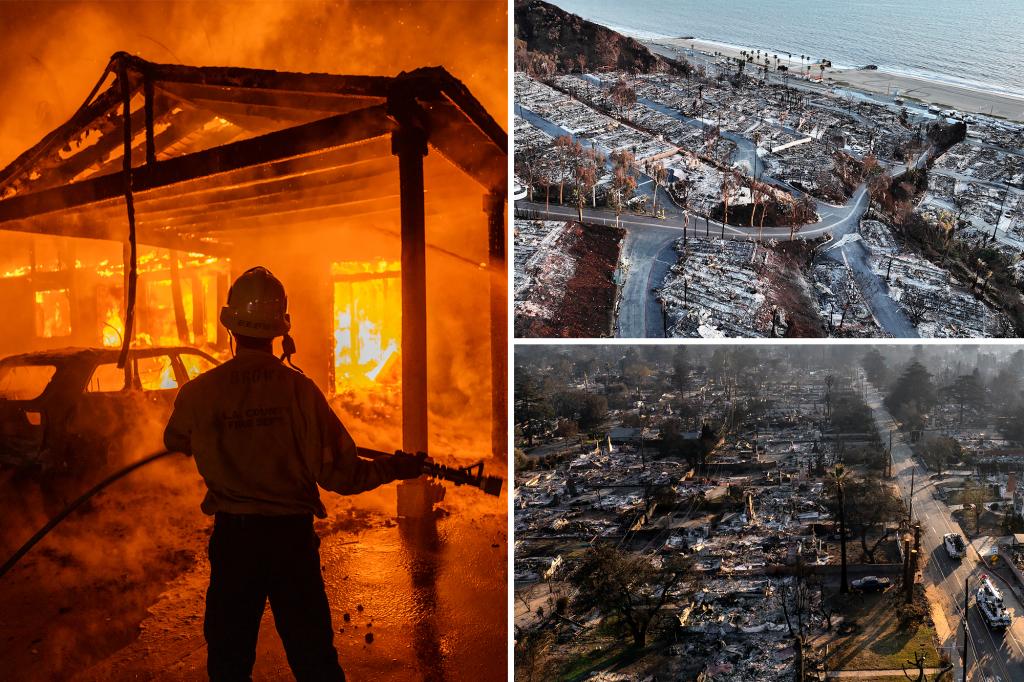The devastating Palisades and Eaton wildfires, which ravaged Los Angeles and the nearby Altadena area for over three weeks, have finally been declared 100% contained. This long-awaited announcement from the California Department of Forestry and Fire Protection marks a significant turning point in the battle against these destructive blazes. While the fires continue to burn within the established perimeters, the containment status signifies that firefighters have successfully encircled the blazes, preventing further spread and bringing them under control. This achievement represents the culmination of weeks of relentless efforts by first responders who battled tirelessly against challenging terrain and unpredictable weather conditions.
The Palisades Fire, which ignited on January 7th in the affluent Pacific Palisades neighborhood of Los Angeles, consumed a staggering 23,448 acres, leaving a trail of destruction in its wake. The fire tragically claimed the lives of twelve Angelinos as it relentlessly swept through residential areas, displacing families and leaving a community in mourning. Simultaneously, the Eaton Fire, also sparked on January 7th, raged through the Altadena area of Los Angeles County, scorching over 14,000 acres and resulting in the deaths of seventeen residents. The combined impact of these two infernos has left an indelible scar on the region, both physically and emotionally.
The sheer scale of destruction wrought by the Palisades and Eaton fires is difficult to comprehend. Over 16,000 structures, encompassing homes, businesses, and vital community infrastructure, were reduced to ashes in both urban and residential areas. The economic toll of the fires is staggering, with insured property damage estimates exceeding $28 billion. This figure represents not only the loss of physical assets but also the disruption to livelihoods, businesses, and the overall economic vitality of the affected areas. Beyond the immediate financial impact, the fires have also caused immeasurable emotional distress and disruption to the lives of countless individuals and families.
Following weeks of dry conditions, welcomed rain showers finally arrived in Southern California on Monday, offering a respite from the relentless fires and providing much-needed moisture to the parched landscape. This rainfall, the first significant precipitation in nearly eight months, marked a crucial turning point in the fight against the wildfires, assisting in dampening the flames and reducing the risk of further spread. However, the relief brought by the rain was accompanied by new challenges. The intense downpours led to widespread flooding and mudslides, forcing the closure of the iconic Pacific Coast Highway, a vital transportation artery and a popular scenic route.
The closure of the Pacific Coast Highway, renowned for its breathtaking coastal views, further compounded the disruptions caused by the wildfires. The highway’s closure not only impacted travel and tourism but also hampered access for emergency services and residents attempting to navigate the fire-affected areas. While the closure was necessary to ensure public safety and allow for damage assessment and repairs, it underscored the multifaceted challenges facing the region in the aftermath of the fires. The prolonged closure of such a vital artery further highlights the interconnectedness of infrastructure and the cascading impacts of natural disasters.
In a positive development amidst the ongoing challenges, Governor Gavin Newsom announced on Friday that the Pacific Coast Highway will officially reopen on Sunday. This reopening signifies a significant step towards recovery and a return to normalcy for the affected communities. The restoration of access along this vital route will facilitate the movement of goods, services, and people, supporting the ongoing recovery efforts and enabling residents to rebuild their lives. While the scars of the Palisades and Eaton fires will undoubtedly remain for years to come, the reopening of the Pacific Coast Highway represents a symbolic step towards healing and resilience. The focus now shifts to the long and arduous process of rebuilding homes, businesses, and lives, while simultaneously implementing measures to mitigate the risks of future wildfires and enhance community preparedness.

